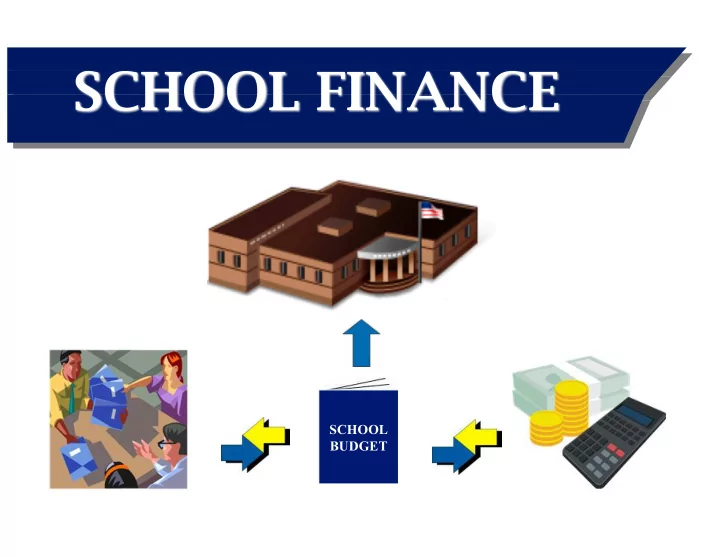

SCHOOL FINANCE SCHOOL BUDGET
I. School District Total Revenue Sources ( State Report Card) State Your Average District State 49.2% ?? % Local 39.4% ?? % Federal 11.4% ?? % 2
State Funding Where does it come from? Ø Sales Tax Ø Mixed Drink Tax Ø Cigarette Tax – BEP 2.0 3
State Funding How is it determined? Basic Education Program (BEP) Formula that determines the funding level required for each school system to provide a common, basic level of service for all students. 4
BEP Funding Formula History Ø Adopted by the Legislature in 1992 as part of the Education Improvement Act (EIA) Ø Developed in response to Small Schools I lawsuit, where TN Supreme Court ruled State’s previous school funding formula was inequitable Ø “Funding formula, not a spending plan” 5
BEP Funding Formula Highlights 1. Comprehensive 2. Attempts to equalize state and local funding (fiscal capacity; cost differential factor) 3. Provides flexibility 4. Attempts to keep up with increased costs 6
BEP Funding Formula Comprehensive Formula contains a number of components (46 total) that the Legislature has deemed necessary for schools to succeed. 7
Determining Need - ADMs Ø ADMs (student enrollment) drive the formula – funded on prior year’s ADMs • Note: LEAs also receive growth funding based on current year growth. This is outside the BEP, but distributed based on the BEP formula Ø ADMs generate: • Positions – teachers, supervisors, assistants • Funding – ADMs are multiplied by a Unit Cost for supplies, equipment, textbooks, travel, capital outlay, etc. Ø Funding months and weighting • Month 2 – 12.5% Month 6 – 35% • Month 3 – 17.5% Month 7 – 35% 8
BEP Funding Formula 4 Categories Formula contains instructional salaries, instructional benefits, classroom and non-classroom components: Ø Instructional Components (State = 70% / Local = 30%) • Example: Teaching Positions Ø Classroom Components (State = 75% / Local = 25%) • Example: Textbooks, Instructional Equipment Ø Non-Classroom Components (State = 50% / Local = 50%) • Example: Capital Outlay, Transportation 9
BEP Funding Formula Equalization Formula determines actual state share of education funding by each county’s relative ability to fund education from its own local sources: “FISCAL CAPACITY” 10
Fiscal Capacity Ø County’s “ability to pay” • Fiscal Capacity Indices provided by: o Tennessee Advisory Commission on Intergovernmental Relations (TACIR) o UT Center for Business and Economic Research (CBER) Ø Expressed as an index measure, which is a proportion of the total fiscal capacity for all counties 11
Fiscal Capacity TACIR Model (complex multiple-regression model) Ø Per pupil own-source revenue Ø Per pupil equalized property assessment Ø Per pupil taxable sales Ø Per capita income Ø Tax Burden Ø Service Burden 12
Fiscal Capacity CBER Model (newer model per BEP 2.0) Ø Determines a county’s capacity to raise local revenues for education from its property and sales tax base Ø Each county’s fiscal capacity is the sum of: • The County’s equalized assessed property plus IDBs multiplied by a statewide average property tax rate for education • The County’s sales tax base multiplied by a statewide sales tax rate for education 13
Cost Differential Factor (CDF) Ø Used to adjust BEP funding in systems where the cost of living in the county is greater than the statewide average Ø Compares county wages in non-government industries to statewide wages Ø Counties with above-average wages according to this index receive an increase Ø Increase is applied to salaries, retirement contributions and FICA contributions Ø Eliminated in BEP 2.0 Ø Counties receiving an adjustment currently receive 25% of the calculated CDF 14
BEP Funding Formula Flexibility Ø School boards have broad flexibility in determining how to allocate state funds. 12
BEP Funding Formula Cost evaluation Ø BEP component costs are recalculated and updated for inflation each year. 13
BEP – many inputs ADMs Fiscal Capacity CDF Salaries, BEP Unit Costs Retirement, Insurance 16
BEP Components (46) by Category Instructional Classroom Non-Classroom Regular Education K-12 At-risk Superintendent Career & Technical Education Duty-free Lunch System Secretarial Support Special Education Textbooks Technology Coordinators Elementary Guidance Classroom Materials and Supplies School Secretaries Secondary Guidance Instructional Equipment Maintenance and Operations Elementary Art Classroom Related Travel Non-instructional Equipment Elementary Music CTE Center Transportation Pupil Transportation Elementary Physical Education Technology Staff Benefits, Insurance, Retirement Elementary Librarians (K-8) Nurses Capital Outlay Secondary Librarians (9-12) Instructional Assistants ELL Instructors Special Education Assistants ELL Translators Staff Benefits, Insurance, Retirement Principals Substitute Teachers Assistant Principals Elementary Alternative schools Assistant Principals Secondary System-wide Instructional Supervisors Special Education Supervisors Career and Technical Education Supervisors Special Education Assessment Social Workers Psychologists RTII Staff Benefits, Insurance, Retirement 17
For further information… Ø Tennessee Basic Education Program: An Analysis § https://www.comptroller.tn.gov/office-functions/research-and- education-accountability/legislative-toolkit/bep.html See the Legislative Brief Ø State Board of Education § https://www.tn.gov/sbe/committees-and-initiatives/the-basic- education-program.html § BEP Blue Book – up to date data on BEP components § Recommendations of the BEP Review Committee § BEP Handbook for Computation– comprehensive guide on calculations 21
SCHOOL FINANCE THANK YOU!
Recommend
More recommend